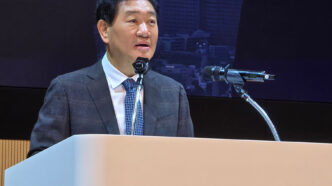Samsung Electronics has posted its highest-ever quarterly revenue in Q1 2025, driven by its continued investment in artificial intelligence (AI). Despite facing challenges in the semiconductor market and rising global trade tensions, the South Korean tech giant saw significant growth, reaching KRW 79.14 trillion ($55.4 billion), a 10% increase compared to the same period last year. Operating profit also rose by 1.5%, reaching KRW 6.7 trillion ($4.68 billion), surpassing both the company’s initial forecast and analysts’ predictions.
Smartphone Business Shines Amid Semiconductor Challenges
Samsung’s Mobile Experience (MX) Business was the standout performer, contributing KRW 37 trillion in consolidated revenue and KRW 4.3 trillion in operating profit, its highest in four years. The company attributes this success to strong sales of its Galaxy S25 series, which leverages advanced AI features through Galaxy AI.
“Improved cost efficiency and a reduction in some component prices also contributed to the solid profitability,” said the company’s earnings report. However, the semiconductor division, Samsung’s Device Solutions (DS), posted a sharp decline, with KRW 25.1 trillion in revenue and a 42% drop in operating profit. This reflects ongoing struggles in the semiconductor market, especially in the high-bandwidth memory (HBM) sector, which has been hit by export controls and delayed demand.
While Samsung’s Q1 results were impressive, the company expressed caution regarding the outlook for Q2 2025. The company refrained from offering specific guidance, citing global trade tensions and economic uncertainties. In particular, ongoing geopolitical issues, such as the potential impact of US President Donald Trump’s tariffs, have raised concerns about the future. Although Samsung’s flagship products remain exempt from these tariffs, the company is closely monitoring potential product-specific investigations.
“We are engaging with related countries to mitigate the negative impacts of these uncertainties,” Samsung stated. Additionally, the company is considering relocating the production of some items like TVs and home appliances to better navigate these global challenges.
AI Investment and Strategic Focus for Future Growth
Samsung remains firmly committed to its AI strategy, allocating a record amount to its research and development (R&D) efforts. In Q1 2025, R&D spending increased by 16%, reaching KRW 9 trillion. The company is focused on expanding its AI-driven smartphone lineup, including the introduction of “Awesome Intelligence” to the Galaxy A series and the launch of the Galaxy S25 Edge in Q2 2025. Later in the year, Samsung plans to enhance its foldable smartphone lineup with improved AI-driven user experiences.
In the semiconductor space, Samsung is focusing on its high-value-added server portfolio, specifically the upcoming HBM3E 12H products. The company anticipates strong demand for AI-related products, especially with new GPUs launching in the second half of 2025. Samsung also aims to lead the shift toward on-device AI in mobile and PC markets with its industry-leading 10.7Gbps LPDDR5x memory.
Competitive Landscape and Market Outlook
Despite the positive revenue, Samsung’s share price fell by 0.6%, reflecting concerns over the uncertain market environment. The company faces increasing competition, particularly from local rival SK Hynix, which recently reported a 158% increase in operating profit. SK Hynix’s success in the high-bandwidth memory sector has allowed it to surpass Samsung in global DRAM market share, with 36% compared to Samsung’s 34%, according to Counterpoint Research.
“While uncertainties remain, we expect our performance to improve in the second half of the year,” Samsung said, maintaining an optimistic outlook despite challenges.
Samsung’s record revenue underscores its success in consumer-facing applications like AI-powered smartphones. However, the company’s semiconductor division, a historically dominant force, faces significant pressure in the evolving AI market. With intense competition from players like SK Hynix and ongoing geopolitical risks, the coming quarters will be critical for Samsung’s AI semiconductor strategy.
The future of Samsung’s semiconductor business may depend on its ability to recover lost ground in high-value memory markets, which could define the company’s place in the global AI supply chain for years to come.













